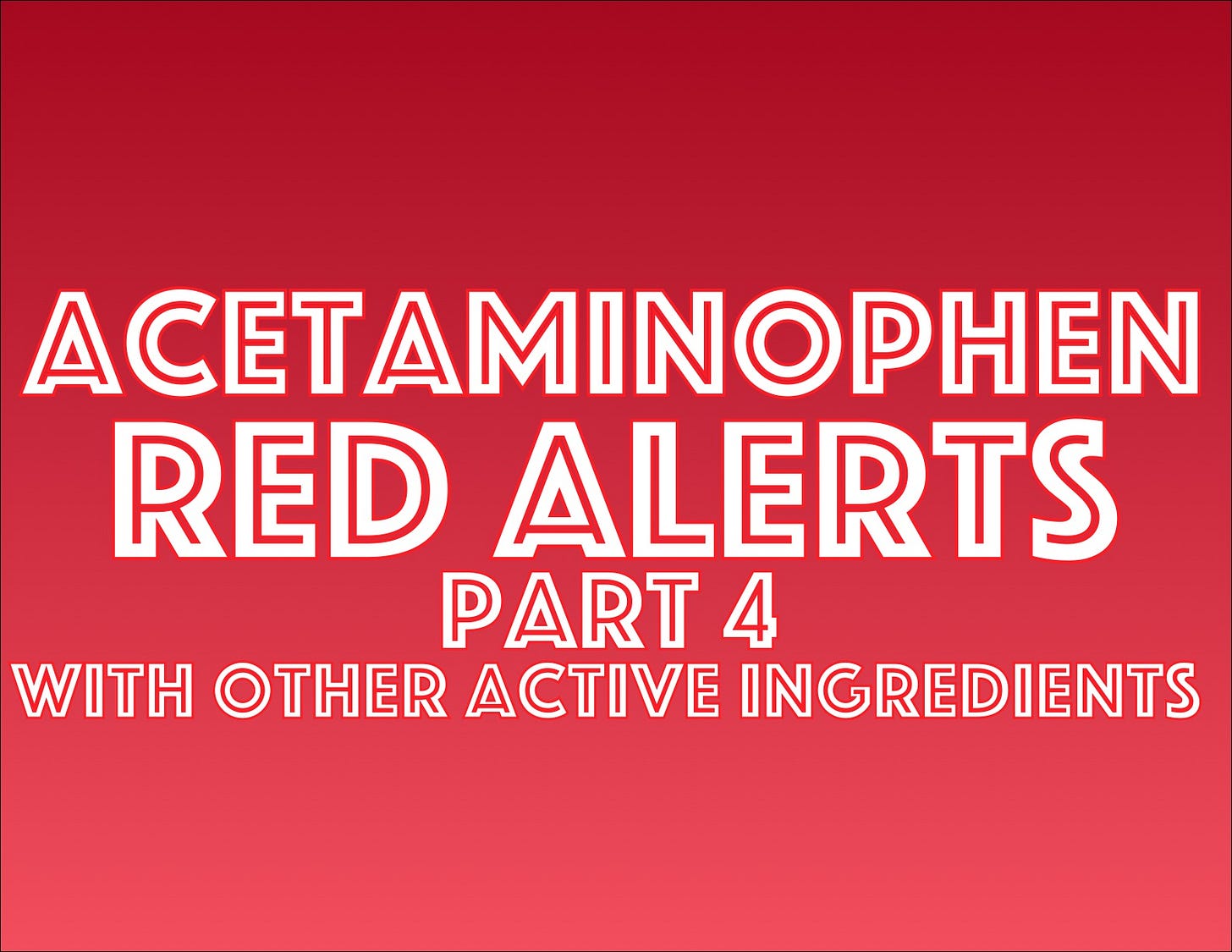ACETAMINOPHEN RED ALERT Part 4: With Other Active Ingredients
Acetaminophen is extremely common in OTC meds for pain, nasal allergies, cold symptoms and cough.
Combination drugs, featuring two or more active ingredients, are a relatively new concept in modern medicine. Since the late 1970s, this idea has been enthusiastically put to use by manufacturers of OTC and prescription products. The top 4 categories of OTC meds that include acetaminophen are pain, nasal congestion, allergic rhinitis and, tied for 3rd place, cough and cold.
Among the 500-600 OTC cold-and-flu combinations currently available are name brands s like Vicks DayQuil & Vicks NyQuil, Duraflu, Excedrin Migraine, Mucinex Sinus Max Pressure & Pain, Tylenol Cold & Flu, Tylenol Sinus, and Advil Dual Action as well as numerous generic and store brand mimics. Often, the ingredients include acetaminophen.
A generic product label proclaiming, “Compare to XYZ Name brand” doesn’t necessarily have the same ingredients or ratio. It might just be that both have ingredients intended for similar symptoms. Acetaminophen is common in generic products, too.
The contents of most multiple-symptom respiratory remedies can be condensed into a list of about a dozen frequently-included ingredients. A typical product has 3-5 chemicals from this list, not counting acetaminophen. Name brands often have several products with slightly different names and slightly different formulas. The website Very Well Health reports 3 of 7 NyQuil products include 10% alcohol. No DayQuil or Children’s NyQuil contain alcohol. Children’s NyQuil is the only item in this product line without acetaminophen.
The opportunities to reconfigure the dozen most common respiratory symptom ingredients into endless different groupings and ratios, with or without acetaminophen, means the manufacturers will always be able to produce new formulations without having to develop or discover new ingredients. Just add one, subtract one or swap one from the usual ingredients.
When hit with cold or flu symptoms, patience and reading comprehension possibly compromised, one faces a multitude of options. If combination products weren’t a thing, there would be about a dozen medications to match to current symptoms, plus either aspirin or acetaminophen for fever and pain.
There’s scant evidence of efficacy for ingredients in widely-available cold-and-flu formulas. The 1976 update of the Pure Food & Drug Act required the FDA to ensure drugs on the market be safe and effective. But testing products already on the market were not a priority. Weak, perhaps doctored data for phenylephrine, was allowed to slide because this drug, the “PE” in Sudafed PE, accounted for 1/4 of the decongestant market in the wake of the meth moral panic, when the actual active ingredient in Sudafed, while still technically OTC, could only be purchased with photo ID. Still, the mounting evidence of inefficacy was so strong that, in 2023, the FDA conclusively
declared “PE” is ineffective.
Data suggests two other very common ingredients, guaifenesin, and dextromethorphan are also ineffective. But lack of effectiveness doesn’t mean they don’t have side effects. For example, phenylephrine doesn’t reduce mucus production, but it may constrict blood vessels.
When feeling sick and miserable, we face extreme restrictions on the opioid medications our ancestors used, such as codeine. But there is one thing we can do that our ancestors did — take a shot of brandy and go to bed.

